How to properly pinch cucumbers in a greenhouse: rules of care from planting to harvest
The formation of cucumber bushes is an important agrotechnical measure, the meaning of which is the selective removal of parts of the plant. If this procedure is neglected, the crop yield decreases, the quality of the fruit suffers, and their ripening begins later. Let's look at the rules for pinching cucumbers and caring for them in a greenhouse from planting to harvest.
What is pinching and what is it for?
The term “pinch” means to remove, tear off with your fingers or garden tools the growing point - the apical bud.
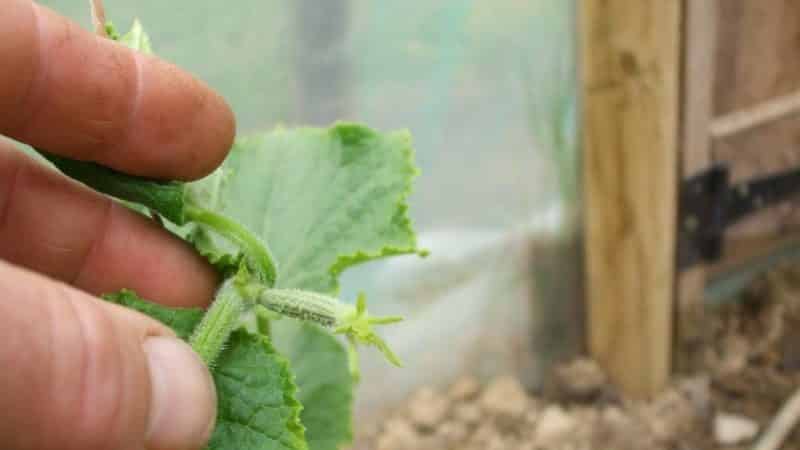
Pinching is carried out to prevent the following factors:
- severe thickening of the bush, which leads to a lack of lighting;
- poor ventilation of plants;
- a large number of barren flowers;
- spread of pests and diseases.
The procedure promotes the development of the root system, and this is one of the main factors influencing the size and number of ripening fruits.
What other stages of cucumber care are there?
In addition to pinching, cucumbers are given the correct watering regime - at least 5 liters of water per 1 m2, preferably in the morning, before the heat sets in. After moistening, the soil is loosened, allowing the roots access to oxygen. During the season, fertilize the plants 3-4 times, using both organic and artificial fertilizers.
The air temperature in the greenhouse is maintained at +18…+30°C. The optimal humidity is at least 80%; with mandatory daily ventilation, drafts are not allowed.The bushes are formed and tied up in time, using vertical or horizontal supports.
Benefits of pinching cucumbers in a greenhouse
Already while tying the seedlings to the support, the first manipulations to form the bushes are carried out. Pinching plants in a greenhouse affects the formation of ovaries, helping cucumbers produce more female flowers than male barren flowers.
Strongly overgrown bushes do not allow the fruits to grow large enough and affect the taste - even young greens begin to taste bitter if the plant gives up its juices to the voluminous leaf mass.
Reference! When forming bushes, you should not remove too many leaves - this can affect the rate of photosynthesis. The approximate number of leaves required for rapid ripening of the crop is calculated as follows: 1 leaf per 1 ovary.
When to pinch bushes
2 weeks after planting the seedlings in the greenhouse, they begin to fasten the bushes to the supports and shape them. When the plants are sufficiently adapted and their root system is well established in the soil, the main stem is tied to a support with wire or twine.
As it grows, remove excess shoots, weak and yellowed leaves, and parts infected with infection or pests. If a large number of barren flowers appear on the bushes, first try to dry the too moist soil; if this does not help, pinching is carried out, removing the male flowers.
How to properly pinch cucumbers in a greenhouse
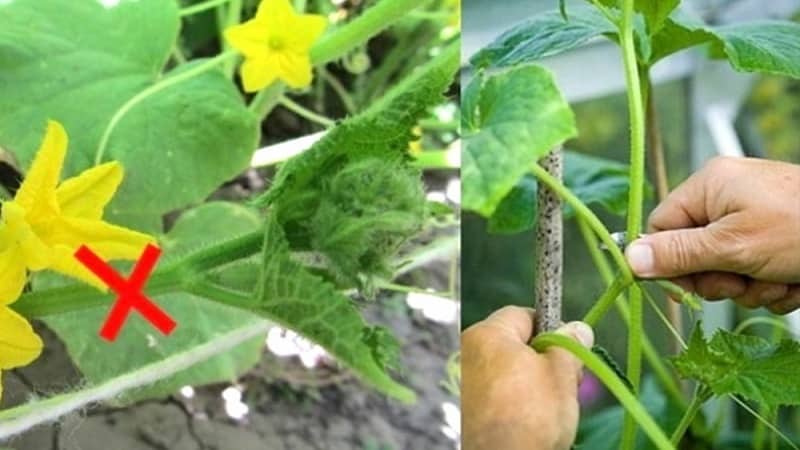
Separate parts of the plant with sharp scissors or with your hands using your index finger and thumb, tightly squeezing the stem and carefully pinching off what is unnecessary. Thin young stepsons are more convenient to remove by hand, since they are soft and brittle.If pinching is carried out using tools, their blades are pre-sharpened and disinfected.
Leave stumps 0.5–1 cm high. Remove male flowers, tendrils and stepsons in the leaf axils. You cannot roughly break off the stem or tear off the growing point.
Reference! Modern bush varieties with determinate lateral shoots do not require pinching. The ovaries of such bushes are often formed in “bouquets”, so removing the growth points will disrupt the natural process and lead to an overload of the plant with fruits.
The event is carried out on a dry day, when the above-ground part of the bushes is completely dry after watering. This procedure not only stimulates the appearance of ovaries, but also rejuvenates the plant.
According to the classical scheme of insect-pollinated varieties and hybrids
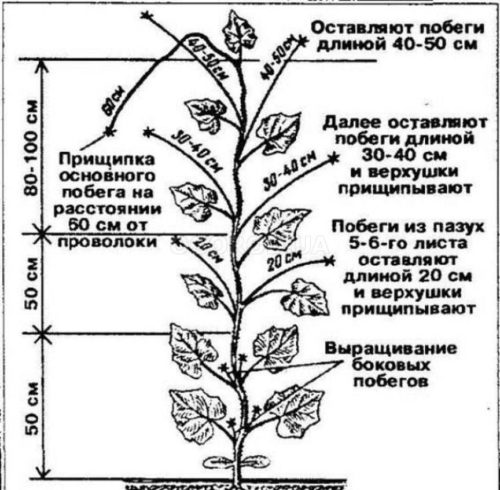
The load on the bush according to the classical scheme increases gradually from bottom to top: the higher the plant, the more shoots, ovaries and leaves are left:
- When the main stems grow to a height of 50 cm, a “blinding zone” is made. To do this, remove all side shoots that appear below the axil of the 6th leaf.
- Up to a height of 100 cm, all lateral shoots are pinched above the first leaf, leaving 1 ovary.
- At a height of 100 to 150 cm, only 3-4 shoots are left, shoots with 2 ovaries and the same number of leaves are formed.
- A stem over 150 cm long is thrown over a trellis, the next 3-4 lateral shoots are pinched above 3-4 ovaries.
- The upper growth point of the main lash is removed when the distance from the hanging crown to the ground begins to be 60–70 cm.
Many manufacturers offer a suitable scheme for forming bushes on the seed package. In this case, it is better to follow the recommendations.
Pinching scheme for self-pollinating species
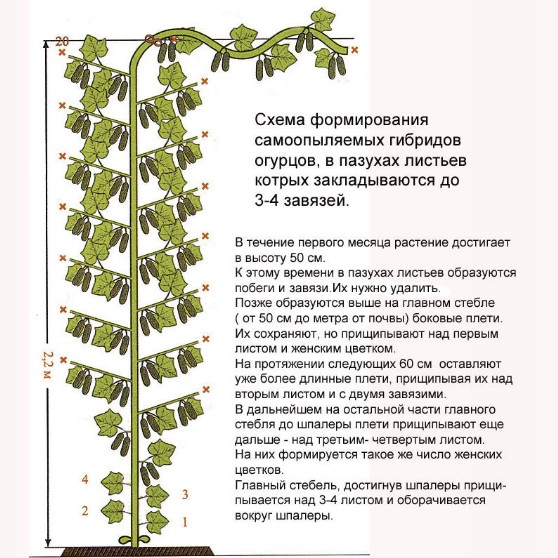
On cucumbers that are not pollinated by insects, female flowers form mainly on the side shoots. Therefore, pinching is done so that many shoots appear. How to pinch self-pollinating cucumbersthat grow in a greenhouse:
- After the first 3 ovaries are formed on the main stem, they are removed.
- The crown of the main lash is removed above the 6th true leaf, stimulating the growth of lateral processes.
- The side shoots are pinched, leaving 3-4 ovaries on each, and carefully tied up, avoiding tangling.
Not all self-pollinating varieties need pinching, but for late cucumbers this procedure is required.
Pinching parthenocarpic varieties and hybrids
Such plants produce mainly female flowers, which are most often formed on the main stem. Plants have a high rate of shoot formation, therefore pinching carried out not only for formation, but also to avoid excessive thickening.
A step-by-step diagram of how to pinch such cucumbers in a greenhouse:
- Blinding is done in the axils of the first 4 true leaves, they are removed along with the flowers.
- The fifth and sixth shoots are shortened, leaving 20 cm.
- 3-4 shoots that appear higher are pinched at a distance of 40 cm, and 3-4 shoots that grow even higher are left 50 cm long.
- After another 5-6 leaves grow, pinch off the main stem.
Hybrids are removed stepsons and extra tendrils formed in the leaf axils. Make sure that the upper long shoots do not get tangled.
Experienced gardeners recommend tearing off the corners of the upper, too large leaves if they shade the lower shoots or reduce their lighting. Such actions will not cause harm, but will increase the area of exposure to sunlight on the lower tiers of tall and powerful bushes.
Further care
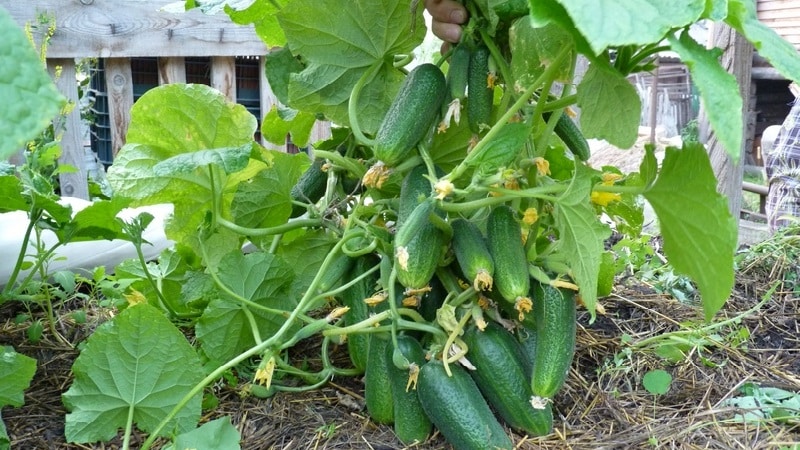
Treated plants are sprinkled with crushed wood ash to disinfect cut areas, dry them and avoid the development of infections. To prevent pinching from causing severe stress to the crop, cucumbers are fed with organic fertilizers after the procedure.
Watering carried out more carefully than usual, trying to prevent drops of water from getting on the stumps remaining in the places where parts of the plant were removed.
Conclusion
Pinching is a necessary procedure for increasing cucumber yield, improving fruit quality. Depending on the variety and type of plant, different schemes for forming bushes are used. Care for cucumbers is carried out regularly, avoiding tangling of the vines or excessive growth of green mass. The procedure rejuvenates old, overgrown bushes.